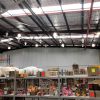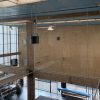
Click here for a HD version of this blog;-Really. Can air circulation and destratification save 30% off my air conditioning bills
Really? Can Air Circulation and Destratification Save 30% Off My Cooling and Heating Bills? ©
If we look at the science behind air flow and cooling there is a large amount of empirical research that details the improvement in thermal comfort from increased air speed in buildings in summer climates, both hot and humid and hot and arid. Whether the air flow is from fans or natural ventilation or both, the use of air movement for cooling over the previous 3,000 years must indicate that the concept works.
To this day, people seek air movement to help keep cool or at least more comfortable in all kinds of warm environments including tropical and sub-tropical as well as hot and arid.
For example, Zhang et al (2007) in their research, detail how overheated people seek more air movement in hot and humid tropical environments.
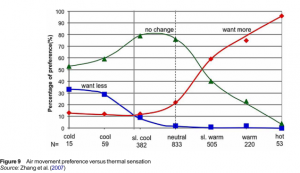
In further research, Professor Richard Aynsley, formerly Professor of Tropical Architecture at James Cook University in QLD, details how air movement of 3m/s second will offer around 7 degrees of SET cooling on a 36 degree, 70% humidity day.
Now that means an overheated person can use air movement to improve how they feel so that in a 36 Deg. C. humid day they will feel like it is 28 Deg. C. That’s an effective form of cooling! If you use an efficient fan to create that air movement then the cooling will be achieved for almost zero energy.
Generally, this can be achieved using fans such as HVLS type large bladed fans or very low energy Airius® Air Pears.
Air conditioning systems are not designed to provide this level of controllable and directional, relatively high-speed air movement, in a space, especially at the floor level or thereabouts where it is needed.
There are a range of air delivery issues that occur in air conditioning systems and with a typical register discharge speed of 0.2-0.5 m/s, and discharge registers located art ceiling level, air flow velocity often becomes very limited at ground level. A lot of energy is wasted in trying to push or force cold or warm air to the floor for a range of reasons.
However, using fan based air movement technology, in the room itself, can also offer some significant energy savings in summer in air conditioned spaces by substituting air conditioning supplied cold air, up to a certain air conditioning temperature, with cooling air movement.
In an air conditioned commercial buildings, air conditioning can consume 30-60% of the building’s energy.
If we follow the research noted above (and further research on this topic is detailed in our Airius Blog ‘Air Movement for Cooling in Hot and Humid and Hot and Arid Environments’) we know that air movement can provide significant comfort improvements in warmer and hot climates.
Certainly, it’s not perfect but it’s a good alternative if you want to maintain comfort and reduce air conditioning energy use.
Now, in some facility types such as offices or supermarkets etc, 3 m/s a second is too high an air speed. For those 1- 1.5 metres a second will offer a perception of 3-4 Deg. C. reduction in temperature. In other facilities such as sports halls or warehouses 3m/s or even 2m/s would be acceptable.
In this chart below, ASHRAE indicates in a Sydney summer climate only 1m/s air speed will offer a 4 Deg. C. temperature offset.

If you or your client are interested in saving air conditioning cooling energy without massive changes to their system or facility then this option should be given detailed consideration.
Dr Vahid Vakiloroaya, from the University of Western Sydney, and winner of the 2016 Innovative Engineering Award from Engineers Australia (and designer of the IP Hybrid Air conditioning system), has undertaken some interesting research around energy savings achieved by air conditioning systems by simply changing thermostat setting changes in the Sydney summer climate. His research indicates significant energy savings. Simply by changing the thermostat setting.
Now this isn’t a new concept. There is a raft of research available on the amount of energy savings achievable per Degree C. if you change the thermostat set points. Of course, there are numerous conditions and qualifications around the percentage savings but 8-10% /Degree C. is often quoted as typical figure.
However, if you understand and agree that air movement can offer a good substitute for cooling across a certain range of climatic conditions and comfort expectations, then the combination of air circulation and air conditioning in summer can reward a client with energy savings of up to or even greater than 30% while still maintaining a high level of thermal comfort -simply by installing a some fans and changing the A/C thermostat in the space.
Have a look at this graph below from Dr Vahid’s Research.

Dr Vahid undertook simulations in the Sydney cooling seasons of January, February, March and October, November and December using a 5 KW wall mounted split air conditioning unit in an office building.
If we consider the normal building has a set point of around 22 Deg. C. and we know that 3m/s air movement can offer a 7-Deg. C. cooling effect on a hot and humid day, then the impact of air movement offering cooling in a dryer, conditioned environment, where it’s not so humid, will be even greater.
It would be possible to increase the thermostat from 22 Deg.C to say, 26 or even 27 Deg. C. on a hot day using 1-1.5 m/s air speed /movement as an energy efficient cooling substitute, and people inside the building will feel like it’s around 22-23 Deg. C. That’s what the latest thermal comfort research indicates.
Based upon Dr Vahid’s research outcomes below, increasing the thermostat from 22-25 Deg.C. will save around 30% of your cooling energy! Which can be achieved using only 0.8 -1m/s air speed.
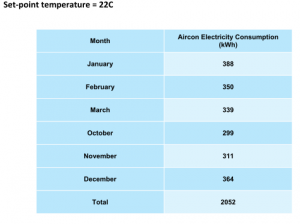

Dr Vahid indicates each degree increase in thermostat set point in summer, saves around 8-9 per cent of cooling energy use of the air conditioning system.
So over 3 Deg. C. that’s a 25-27% saving.
Over 5 Deg. C. that’s a 40% saving.
Remember, at say 27 Deg. C. internal thermostat set point, the air movement as a substitute for air conditioning is offering the same level of thermal comfort as the 22 Deg. C air conditioned space. While saving 40% of cooling energy!
That’s a significant reduction especially when implemented into a larger A/C system.
If you are spending, for example, $100,000 per annum on cooling in a large facility, that’s a $25-$40,000 Per Annum energy saving initiative just for installing some fans and changing a thermostat setting.
Returns on investment will be very short as fans are not very expensive. If, for example, you want to work on a 2-year ROI, with those sorts of savings then you can afford to spend up to $80,000 on your fans. And get that back in 2 years. And then save $40,000 per annum!.
What About Heating?
Now if you also have a heating environment, say you live in a part of Australia that has heating requirements, then the use of high quality, air circulation, and particularly destratification fans, (which can effectively circulate air in summer and destratify spaces in winter in the one unit) will save you large amounts of heating energy too.
When you heat your building all the warm air is rising to the roof or ceiling. That’s just physics. No matter the A/C register design, or location of the outlets, or heating types such as radiant or in floor, all the warm air makes its way up to the ceiling.
Therefore, it’s not where you need it.
What you really want is to push it down to the floor so you can feel the heat and stop overdelivering warm air that just makes the ceiling feel warmer. Not you. That overdeliver (wasting) of heat is going to significantly increase your heating bill… all for nothing. Simply, its wasted heat and wasted energy.
However, there are difficulties for standard or traditional air delivery systems trying to push the warm air to the floor, as its lighter than the cold air and is always wanting to rise back up again. This is especially difficult when it comes to the very cold facilities where the dense cold air is sitting in thick layers on the floor. And this is where an air turbine design comes in. Located up under the roof its patented and unique design means it can push the lighter warm air down and through these dense cold layers, destratifying the space and optimising the effectiveness of your heating.
Once it is explained to you it makes sense doesn’t it.? No smoke and mirrors here.
In the UK, detailed research was undertaken on the efficacy of air turbines to destratify a space.
Some interesting results were achieved and these outcomes are commonly achieved worldwide in real world situations.
This chart below highlights the energy savings achieved in a heated environment by using air turbine destratification fans. This research was carried out by BSRIA in the UK. They are similar to the UK’s CSIRO.
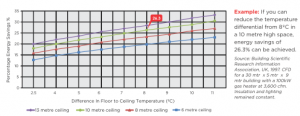
The research indicates, for example, in a 6-metre-high space with a 6 Deg. C. difference in floor to ceiling temperatures (this is known as stratification) a heating energy saving of 18% is achievable. And that is before any changes are made to thermostat in the room (which often occurs when you now have all the warm air at the floor in winter) …it becomes too hot!
Usually 0.75-1 Deg. C. temperature increase per metre in height is typical of stratification levels in a building.
In winter, if you decrease the thermostat from say 22 Deg. C. to 20 Deg. C. (as often happens when destratification is implemented as its now so much more comfortable you can also turn your heating down), even greater energy savings can be achieved).
So, through the use of air circulation in summer and the associated initiative of changing the thermostat to compensate for that cooling air movement, and via effective destratification in winter, significant air conditioning energy savings can be achieved.
Of course, the implementation costs and practicality of that installation and product options need to be looked at. Large bladed fans often bring a range of installation difficulties and costs to many types of buildings and these constraints can be insurmountable in facilities such as offices or supermarkets or other areas where HVLS type large rotating fan blades, installation requiring roofing structural changes , three phase power and ongoing maintenance requirements, makes those types of fans impractical and too expensive to persevere with.
To create the best value, the small but powerful air turbines manufactured by Airius® are often the easiest and most cost-effective implementation solution.
This smart product selection leads to even shorter paybacks. Their proven efficacy in offering both strong air movement for summer cooling and effective destratifcation for winter heating environments, combined with their very low power use and ease of install makes them a simple energy saving solution for any building up to 40 metres high.
Now I want to be clear here, convincing customers that they can substitute air flow for air conditioning to provide cooling, up to a certain point, is not easy and despite the science around thermal comfort, energy savings and air movement being clear and unequivocal, some engineers and clients find it hard to digest.
Subsequently at this stage there is little practical, installed evidence in Australia, highlighting these opportunities for summer cooling. But now the cost of power is once again becoming a major concern and the Federal government’s intent to use building energy efficiency to meet its Paris 2015 climate targets, then the engineering and energy auditing fraternity may well reconsider and look at the use of air movement across a range of temperatures to replace or, more likely, complement, energy hungry air conditioning, especially in those warm climates where most of the summer seasons are not excruciatingly hot.’
For example, if we take Sydney, most of its summer mean maximum temperatures sit around 26 Deg. C. (www.bom.gov.au)
So when the day is a typical summers day, then the air movement can be turned on and the thermostat set to 27 Deg C and your client has: –
- Comfortable customers feeling like its 22-23 Deg.C
- Significant cooling bill savings
Other buildings located in a broad range of differing climate and geographical areas will also gain great benefit from this strategy. Brisbane, Melbourne, Perth are good examples.
What About Heating Energy Savings?.
In regards to heating, if we look at some examples of heating energy savings using destratification and Air Turbines (like those manufactured by Airius), there is a large amount of evidence available for the value of using destratification to save energy.
For example, in Australia, the Axeman’s Hall of Fame, a museum located in Tasmania, turned off 60% of its heating inside two days after installing Airius destratification and circulation fans.
In the UK, Lush Cosmetics achieved some amazing heating saving statistics using destratification.
- ROI = 26 DAYS!!
- 61% Energy saving on heating system
- Heating spend pre Airius = £26,638.83
- Heating spend post Airius = £7,333.38
- £2,967.50 – Full system & installation cost
- £68.75 – Airius system annual running cost
- Now recirculates process heat for free heating
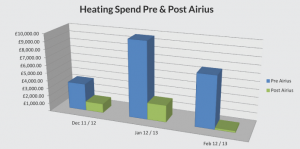
Or Siemens in their train maintenance facility
- ROI = Under 18 months
- £12,106 – First year saving
- £19,799 – Full system and installation cost
- 1,141,113– KwH usage before Airius
- 709,956– KwH usage after Airius
- Installed into Acton rail maintenance shed
- System – 26 Airius Model 45 units
- 75 tonnes – Approx. Annual CO₂ reduction
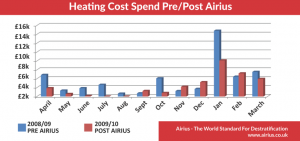
Or Impress Metal Packaging -3 months ROI!
“Overall savings taking into account lower temperatures and prices in winter 08/09 = 45.07%. The full cost of the Airius units is re-coupled within a matter of months –first winter savings of £62,351 measured against a total spend of £21,268.” – Paul Matten (Plant Engineer)

Ok, these are UK installs with their colder climate but nonethlesss, stratification happens in any building in winter. We still need heating here in Australia, just for a lesser period than the UK (except maybe in Tasmania)
Now at this juncture in this blog it’s important to point out something. These savings percentages apply whether you have improved the efficiency of your system or not.
You may have spent large sums of money on higher efficiency chillers or boilers and insulated duct work, or improved controls etc. etc. but still, the end result is that you can’t adjust the thermostat in summer and keep a similar level of thermal comfort unless you circulate air as a cooling substitute, and in winter your hot air is always going to keep rising up away from where you need it.
So, no matter how efficient you have made your system, utilising the suggestions in this blog are still going to offer significant energy savings -the percentages won’t change, just the total amounts of overall energy consumption the percentage savings relate too, may.
If you haven’t done anything to save energy in your building, or have just changed your lighting and want a low cost, simple and effective initiative to reduce your cooling and heating energy bills, then the information contained herein just may offer you a great opportunity.
Airius offers a simple, proven and effective option. This is a simple, easy to install, relatively low-tech solution to saving significant percentages of the air conditioning component of your electricity bills.
Look at these great attributes: –
- Very low running costs
- Minimal operations interruptions
- No or minimal maintenance
- Simple to install,
- No commissioning or programming
What Types of Buildings Will This Work In?
The concepts noted in this blog apply to any building type, from supermarkets to sports halls, to warehouses to libraries to museums to atriums to train stains to prisons… the list of buildings is immense. Cooling air movement and stratification are both physics issues and apply in all building types, just to a lesser or greater extent.
In any building from 2.5 -40 metres high!
Certainly, the greater the height of the building the more stratification occurs in winter, meaning greater heating energy savings. And in summer, the higher the building the more air flow you need to achieve cooling at floor level.
But, in essence, it’s not that hard to achieve the savings if you use the correct type of air movement equipment.
Sounds great, doesn’t it?
If you are serious about saving large amounts of cooling and heating energy, easily, and want ot find out more about air movement for cooling thermal comfort, and effective destratification in winter, call Airius here in Australia on +61 (0) 401 848 888.
We can provide you with the scientific knowhow and an assortment of solutions.
And you can see how Airius can not only improve the comfort in your buildings, but can also save you energy. Lots of it too.
John Brodie
+61 (0) 401 848 888



